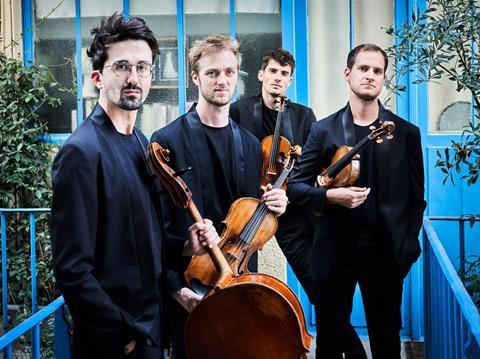Taking its name from Brahms’s second sextet, dedicated to his second love Agathe von Siebold, the group discusses the complexity of the composer’s string quartets, which feature on its debut album.

Discover more Featured Stories like this in The Strad Playing Hub
Brahms’s chamber music is loved, but perhaps the string quartets get overlooked or overshadowed by some of his other chamber works somewhat. What made you decide to record the string quartets?
Raphaël Pagnon: We have always been intrigued by the string quartets! We started by playing the clarinet quintet and the two sextets. The second one, in particular, featuring the theme dedicated to Agathe Von Siebold, gives its name to our quartet. Immediately, we were captivated by the orchestral dimension, the sometimes epic character, but also the tenderness and intimacy that emanate from these works. All of this and more is present in the quartets! The reason they are less frequently performed, in my opinion, lies in the fact that they can be more demanding for the performers. One must make the quartet sound like a sextet or even an orchestra, requiring constant additional commitment. It is also necessary to not only blend the sounds like a choir but, seconds later, speak as a soloist with the sound of a great violinist.
Can you tell us something interesting about the quartets - do they provide a narrative to Brahms’s life, like how Beethoven’s life is profiled through his quartets?
Raphaël: We know that Brahms was extremely tormented, even overwhelmed, by Beethoven’s work when writing his two op. 51 quartets. The result is two works of extreme richness on all levels: harmony, rhythmic intricacies, thematic materials, and structure. It gives the impression that Brahms wanted to encompass everything at once and push the limits of the quartet to meet the challenge. In the third quartet written three years later, he seems to be liberated from this burden and returns to a form of classicism. There is also a kind of audacity that supports this idea. As evidence, consider the third movement with everyone playing muted except the viola. I don’t know of a comparable example in the repertoire.
Simon, you say that the cello parts are some of the most enjoyable to play! How would you describe the string writing in Brahms’s quartets? Are they idiomatic?
Simon Iachemet: I have always enjoyed playing Brahms’ music for multiple reasons. It doesn’t matter if it’s symphonies, sonatas, sextets or quartets – the cello parts are always beautifully written and contain everything us cellists are looking for: splendid bass lines and gorgeous themes. In that sense you can compare them to Beethoven where each part is so marvellous that it could be self sufficient. I also have this very personal feeling that playing Brahms is somehow comfortable for my hands, whereas I find Schubert’s or Schumann’s music a little bit more awkward when you first approach them. Brahms’s music always requires impeccable sound quality, and even if from time to time the music demands some verticality, the sound must always remain of great richness and purity. This quest for the ’most beautiful sound possible’ (according to the meaning of the musical passage obviously) is endless, and I think that playing Brahms’s music results in a more beautiful sound as the music requires a very complex and rich approach to sound.
Adrien, could you tell us about why you decided to arrange op.118 for string quartet?
Adrien Jurkovic: I decided to arrange the Romanze op.118 for string quartet mainly because of its choral qualities; a reminder of Brahms‘s admiration for the vocal repertoire of composers such as Bach and Palestrina. As a quartet, we are able to hold and blend the sounds, something that (with all due respect) the piano cannot do. The feeling of fusion that it gives is probably one of the things we enjoy most as quartet players. Also, the leading voice in this piece is in the middle register. That was without any doubt a viola part. Brahms has shown in many works how much he loved that instrument, and proof of that love can be found in the third movement of the third quartet.
Watch Quatuor Agate’s music video for Brahms’s String Quartet no.1 in C minor, op.51 I. Allegro below. The video and pictures were shot in the limestone quarry of Carrière d’Aubigny. Comprising several hectares, with ceilings up to 16 metres tall, the quarry has been the source of stone that has built French cathedrals, the Paris Opera and the base of the Eiffel Tower.
The video clip, shot by director Marc de Pierrefeu, also shows a more personal side of the quartet.
Quatuor Agate is Adrien Jurkovic, Thomas Descamps, Raphaël Pagnon and Simon Iachamet. Their debut album Brahms - The String Quartets will be released on Appassionato Records on 23 February 2024 and available across all digital streaming platforms.
Review: Agate Quartet: Brahms
Read: Violinist Augustin Hadelich: ‘Just let the music speak’
Read more Featured Stories like this in The Strad Playing Hub
The number one source for playing and teaching books, guides, CDs, calendars and back issues of the magazine.
In The Best of Technique you’ll discover the top playing tips of the world’s leading string players and teachers. It’s packed full of exercises for students, plus examples from the standard repertoire to show you how to integrate the technique into your playing.
The Strad’s Masterclass series brings together the finest string players with some of the greatest string works ever written. Always one of our most popular sections, Masterclass has been an invaluable aid to aspiring soloists, chamber musicians and string teachers since the 1990s.
American collector David L. Fulton amassed one of the 20th century’s finest collections of stringed instruments. This year’s calendar pays tribute to some of these priceless treasures, including Yehudi Menuhin’s celebrated ‘Lord Wilton’ Guarneri, the Carlo Bergonzi once played by Fritz Kreisler, and four instruments by Antonio Stradivari.













































1 Readers' comment